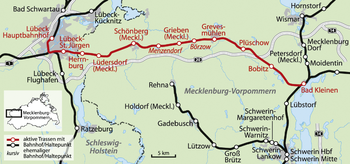Lübeck–Bad Kleinen railway
| Lübeck–Bad Kleinen | |||||||||||||||||||||||||||||||||||||||||||||||||||||||||||||||||||||||||||||||||||||||||||||||||||||||||||||||||||||||||||||||||||||||||||||||||||||||||||||||||||||
|---|---|---|---|---|---|---|---|---|---|---|---|---|---|---|---|---|---|---|---|---|---|---|---|---|---|---|---|---|---|---|---|---|---|---|---|---|---|---|---|---|---|---|---|---|---|---|---|---|---|---|---|---|---|---|---|---|---|---|---|---|---|---|---|---|---|---|---|---|---|---|---|---|---|---|---|---|---|---|---|---|---|---|---|---|---|---|---|---|---|---|---|---|---|---|---|---|---|---|---|---|---|---|---|---|---|---|---|---|---|---|---|---|---|---|---|---|---|---|---|---|---|---|---|---|---|---|---|---|---|---|---|---|---|---|---|---|---|---|---|---|---|---|---|---|---|---|---|---|---|---|---|---|---|---|---|---|---|---|---|---|---|---|---|---|---|
| Route number: | 175 (DR: 782) | ||||||||||||||||||||||||||||||||||||||||||||||||||||||||||||||||||||||||||||||||||||||||||||||||||||||||||||||||||||||||||||||||||||||||||||||||||||||||||||||||||||
| Line number: | 1122 | ||||||||||||||||||||||||||||||||||||||||||||||||||||||||||||||||||||||||||||||||||||||||||||||||||||||||||||||||||||||||||||||||||||||||||||||||||||||||||||||||||||
| Line length: | 61.9 | ||||||||||||||||||||||||||||||||||||||||||||||||||||||||||||||||||||||||||||||||||||||||||||||||||||||||||||||||||||||||||||||||||||||||||||||||||||||||||||||||||||
| Track gauge: | 1435 | ||||||||||||||||||||||||||||||||||||||||||||||||||||||||||||||||||||||||||||||||||||||||||||||||||||||||||||||||||||||||||||||||||||||||||||||||||||||||||||||||||||
|
|||||||||||||||||||||||||||||||||||||||||||||||||||||||||||||||||||||||||||||||||||||||||||||||||||||||||||||||||||||||||||||||||||||||||||||||||||||||||||||||||||||
The Lübeck–Bad Kleinen railway is a single-track, non-electrified main line between the German states of Schleswig-Holstein and Mecklenburg-Vorpommern. Its construction was started by the Lübeck-Kleinen Railway Company (German: Lübeck-Kleinener Eisenbahn-Gesellschaft) and, after that company’s bankruptcy, it was completed and opened by the Friedrich-Franz Railway (Friedrich-Franz-Eisenbahn).
In the 1850s, the two grand duchies of Mecklenburg-Schwerin and Mecklenburg-Strelitz were planning an east-west route through their territory. This would connect in Lübeck to the Lübeck–Büchen line with Kleinen on the Hagenow–Wismar line and run over the existing to Bützow and continue to Güstrow and Neubrandenburg. From there it would run via Strasburg over the modern Polish border to Szczecin (then called Stettin). While the middle section was intended to be a state railway, the western section from Bad Kleinen to Lübeck would be built and operated by a private company.
The newly established Lübeck-Kleinen Railway Company was commissioned in 1865 to construct the line. This was planned to be completed by 1867. However, there was a delay in construction, as the route was changed several times by the company, and it was ultimately not financially able to complete the line. Following its liquidation, the Friedrich-Franz Railway took over and finished construction of the line in 1870. On 1 July 1870, the first train ran over the nearly 60 kilometre-long route.
...
Wikipedia

